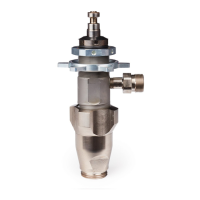Maintenance
3A7004B 15
Maintenance
Preventive Maintenance
Schedule
The operating conditions of your particular system
determine how often maintenance is required. Establish
a preventive maintenance schedule by recording when
and what kind of maintenance is needed, and then
determine a regular schedule for checking your system.
Replace lens covers on regulator gauge lenses when
dirt makes gauges difficult to read.
Tighten Threaded Connections
Before each use, check all hoses for wear or damage.
Replace as necessary. Check that all threaded connec-
tions are tight and leak-free.
Flush the Pump
Flush the pump:
• Before first use
• When changing colors or fluids
• Before repairing equipment
• Before fluid dries or settles out in a dormant pump
(check the pot life of catalyzed fluids)
• At the end of the day
• Before storing the pump.
Flush at the lowest pressure possible. Flush with a fluid
that is compatible with the fluid you are pumping and
with the wetted parts in your system. Check with your
fluid manufacturer or supplier for recommended flushing
fluids and flushing frequency.
1. Follow Pressure Relief Procedure, page 13.
2. Be sure the ES ON/OFF lever is turned to OFF.
3. Place siphon tube in grounded metal pail containing
cleaning fluid.
4. Close gun air regulator (T) and pump air regulator
(X) by turning knob counterclockwise, reducing
pressure to zero.
5. Set pump to lowest possible fluid pressure, and start
pump.
6. Hold a part of the gun firmly to a grounded metal
pail.
7. DataTrak equipped units with runaway protection
only: enable the prime/flush function by pushing the
prime/flush button on the DataTrak.
8. Trigger gun. Flush system until clear solvent flows
from gun.
9. DataTrak equipped units with runaway protection
only: disable the prime/flush function by pushing the
prime/flush button on the DataTrak.
10. Follow Pressure Relief Procedure, page 13.
11. Clean the inside and outside of the suction tube.
Wet Cup
Fill the wet cup 1/3 full with Graco Throat Seal Liquid
(TSL). Maintain level daily.
To avoid fire and explosion, always ground equipment
and waste container. To avoid static sparking and
injury from splashing, always flush at the lowest
possible pressure.

